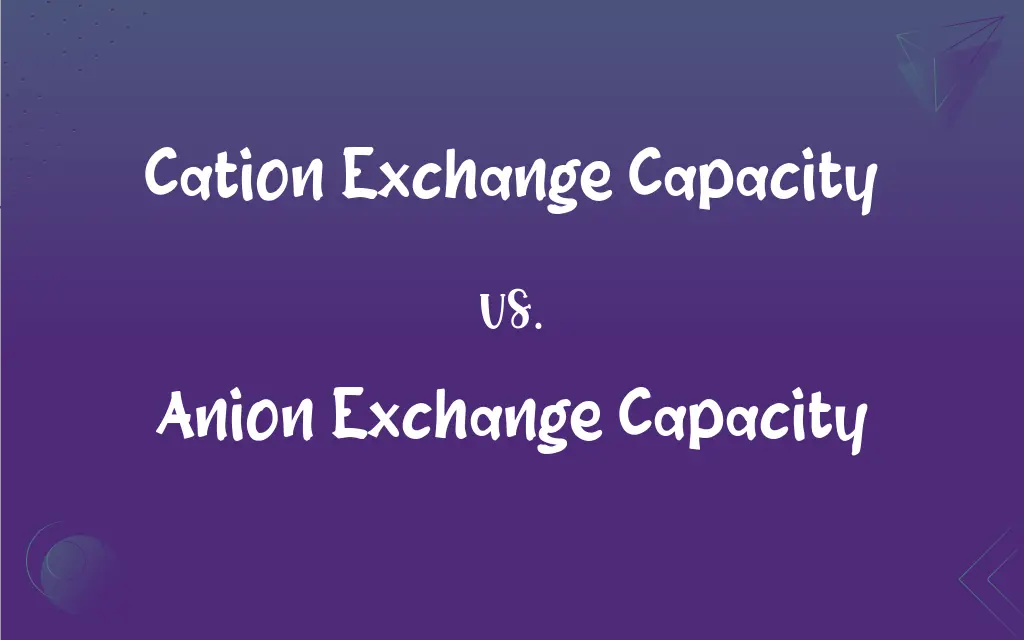Cation Exchange Capacity vs. Anion Exchange Capacity: What's the Difference?
By Harlon Moss & Janet White || Published on November 10, 2024
Cation Exchange Capacity (CEC) measures a soil's ability to hold positively charged ions, crucial for nutrient availability, while Anion Exchange Capacity (AEC) quantifies the capacity to retain negatively charged ions, affecting nutrient leaching.

Key Differences
Cation Exchange Capacity (CEC) is a critical property of soil, reflecting its ability to retain and exchange positively charged ions such as potassium, magnesium, and calcium. These cations are essential for plant nutrition, making CEC an important indicator of soil fertility. On the other hand, Anion Exchange Capacity (AEC) measures a soil's ability to absorb and hold onto negatively charged ions, including nitrate, phosphate, and sulfate, which are also vital nutrients for plant growth.
While CEC is predominantly influenced by the amount and type of clay minerals and organic matter in the soil, AEC is determined by the presence of specific soil minerals that can adsorb anions. The higher the CEC, the greater the soil's capacity to hold onto essential nutrients, reducing the risk of nutrient leaching. Conversely, soils with higher AEC can effectively retain anions, preventing them from being washed away by water, which is crucial in areas prone to heavy rainfall.
CEC is typically higher in soils with a lot of clay and organic matter because these components have a large surface area that attracts cations. Whereas, AEC is less commonly discussed in soil science as most soils have a relatively low capacity to retain anions due to the nature of soil particles and the repulsion between negatively charged soil surfaces and anions.
The balance between CEC and AEC in soil influences nutrient availability, water retention, and soil structure. Soils with high CEC are often more productive because they retain nutrients well, making them readily available to plants. In contrast, the significance of AEC becomes apparent in managing nutrients that are easily leached from the soil, ensuring they remain accessible for plant uptake.
In agricultural practices, managing CEC involves adding organic matter or clay to improve nutrient retention and soil structure. For AEC, the focus may be on adjusting soil pH or using amendments that bind anions, to mitigate nutrient loss, especially in sandy or heavily leached soils.
ADVERTISEMENT
Comparison Chart
Charge of Ions
Positive (e.g., K+, Mg2+, Ca2+)
Negative (e.g., NO3-, PO43-, SO42-)
Influenced by
Amount/type of clay, organic matter
Presence of specific soil minerals
Soil Fertility
Indicates ability to retain essential nutrients
Affects risk of nutrient leaching
Predominant in Soils
High in clay and organic matter
Less common, varies with soil type
Nutrient Availability
Enhances availability of key nutrients
Prevents leaching of certain nutrients
ADVERTISEMENT
Agricultural Management
Addition of organic matter/clay to improve CEC
Adjusting soil pH, using amendments for AEC
Importance
Key indicator of soil fertility and productivity
Important for nutrient conservation in leaching environments
Cation Exchange Capacity and Anion Exchange Capacity Definitions
Cation Exchange Capacity
A measure of how many positively charged ions a soil can hold.
High-CEC soils are better at supplying potassium to crops.
Anion Exchange Capacity
Determined by specific soil minerals that adsorb anions.
The addition of certain clays can improve a soil's AEC.
Cation Exchange Capacity
Managed by adding organic matter or clay amendments.
Amending sandy soils with clay can significantly improve their CEC.
Anion Exchange Capacity
Impacts the effectiveness of soil in nutrient conservation.
High-AEC soils are better at keeping sulfate available for plants.
Cation Exchange Capacity
Influenced by soil's clay and organic content.
Adding compost increases a soil's CEC, enhancing its nutrient retention.
Anion Exchange Capacity
A measure of a soil's ability to retain negatively charged ions.
Soils with high AEC prevent nitrate from leaching.
Cation Exchange Capacity
Essential for retaining nutrients against leaching.
CEC helps prevent essential cations like calcium from being washed away.
Anion Exchange Capacity
Less commonly emphasized but crucial for certain nutrients.
AEC is important for retaining phosphate in soil.
Cation Exchange Capacity
Indicates soil fertility and nutrient availability.
Soils with high CEC values are considered more fertile and productive.
Anion Exchange Capacity
Adjusted through soil pH modification and special amendments.
Liming acidic soils can increase AEC by altering soil chemistry.
FAQs
What does Anion Exchange Capacity indicate?
AEC indicates a soil's capacity to retain negatively charged ions, which is important for preventing nutrient leaching.
Why is CEC important for soil health?
High CEC enhances soil fertility by retaining essential nutrients, making them available to plants, and improving water retention.
How can AEC affect agricultural practices?
AEC affects agricultural practices by influencing how well soils can retain anions, thus impacting fertilizer management and soil amendment strategies.
Can the CEC of a soil be increased?
Yes, the CEC of a soil can be increased by adding organic matter or clay, which enhances its nutrient retention capability.
What is Cation Exchange Capacity?
CEC is a measure of the soil's ability to hold and exchange positively charged ions, crucial for nutrient retention and soil fertility.
Why might AEC be less emphasized than CEC in soil science?
AEC tends to be less emphasized because most soils have a naturally lower capacity to retain anions, and managing cations is often more critical for plant nutrition.
Is Anion Exchange Capacity significant in all soil types?
AEC's significance varies among soil types, being more crucial in soils prone to leaching or those with inherent nutrient retention issues, especially for anions like nitrate and phosphate.
Can improving CEC help in combating soil erosion?
Improving CEC can indirectly help combat soil erosion by enhancing soil structure and aggregate stability, making soils less susceptible to erosion processes.
What agricultural practices can negatively affect CEC and AEC?
Practices such as excessive tillage, overuse of chemical fertilizers, and removal of crop residues can negatively affect CEC and AEC by degrading soil organic matter and altering soil chemistry.
What are common methods to measure Cation Exchange Capacity?
Common methods include the ammonium acetate method and the methylene blue method, which quantify the total amount of exchangeable cations a soil can hold.
How do cover crops influence Cation Exchange Capacity?
Cover crops can improve CEC by adding organic matter to the soil through root exudates and decomposing biomass, enhancing the soil's nutrient-holding capacity.
What role does AEC play in managing soil salinity?
AEC plays a role in managing soil salinity by affecting the soil's ability to retain negatively charged ions, such as chloride, which can contribute to salinity issues. Balancing AEC can help in strategies aimed at reducing the negative impacts of excess salts on soil health.
What factors influence a soil's Anion Exchange Capacity?
A soil's AEC is influenced by its mineral composition and pH, which affect its ability to adsorb and retain anions.
How do CEC and AEC impact water quality?
Both CEC and AEC impact water quality by influencing the soil's ability to retain nutrients and prevent their leaching into water bodies.
What role does organic matter play in CEC and AEC?
Organic matter significantly increases CEC due to its high negative charge density, but its effect on AEC is less direct, often influencing soil pH and microbial activity which can indirectly affect AEC.
Can changes in soil moisture affect CEC and AEC?
Yes, changes in soil moisture can affect CEC and AEC by altering the soil's structure and the mobility of ions, potentially impacting the availability of nutrients.
How does temperature influence Cation Exchange Capacity?
Temperature can influence CEC indirectly by affecting soil organic matter decomposition and microbial activity, which in turn can modify the soil's organic matter content and its cation exchange properties.
How does soil pH affect CEC and AEC?
Soil pH can affect both CEC and AEC; it influences the availability of charge sites for ion exchange and can alter the soil's capacity to retain different ions.
What is the relationship between soil pH and Anion Exchange Capacity?
Soil pH affects AEC by influencing the charge on soil particles and the availability of anion exchange sites; generally, lower pH can decrease AEC by increasing competition for exchange sites.
How do clay minerals affect CEC and AEC?
Clay minerals significantly impact CEC due to their high surface area and charge density, whereas their effect on AEC depends on the type of clay and its specific surface characteristics.
About Author
Written by
Harlon MossHarlon is a seasoned quality moderator and accomplished content writer for Difference Wiki. An alumnus of the prestigious University of California, he earned his degree in Computer Science. Leveraging his academic background, Harlon brings a meticulous and informed perspective to his work, ensuring content accuracy and excellence.
Co-written by
Janet WhiteJanet White has been an esteemed writer and blogger for Difference Wiki. Holding a Master's degree in Science and Medical Journalism from the prestigious Boston University, she has consistently demonstrated her expertise and passion for her field. When she's not immersed in her work, Janet relishes her time exercising, delving into a good book, and cherishing moments with friends and family.







































































